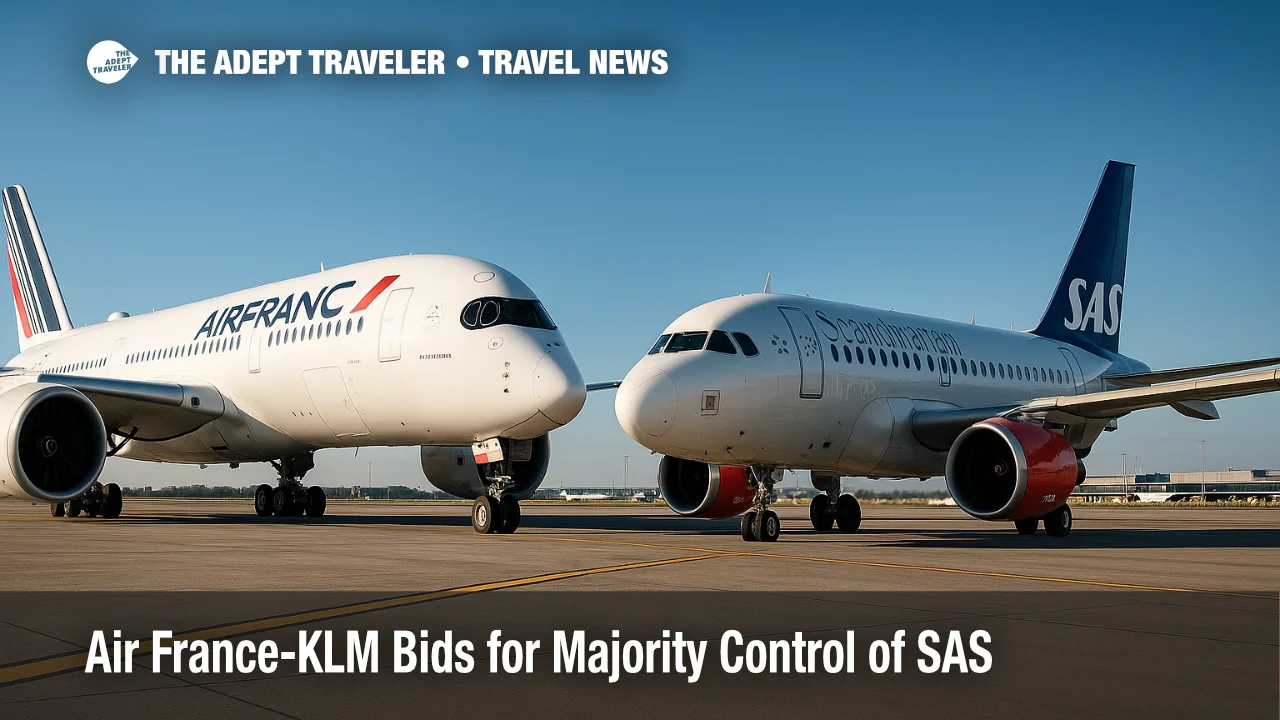Air France-KLM Bids for Majority Control of SAS

Air France-KLM has begun formal steps to lift its holding in Scandinavian Airlines (SAS) from 19.9 percent to 60.5 percent, seeking EU clearance to complete the purchase of shares held by Castlelake and Lind Invest. The French-Dutch group says the move crowns a year of profitable codeshares and SAS's 2024 switch to SkyTeam. If approved, closing is targeted for the second half of 2026, after which SAS would become a subsidiary headquartered in Copenhagen while preserving operations in Oslo and Stockholm. The Danish state intends to keep its 26.4 percent stake.
Key Points
- Why it matters: Consolidates a major Nordic carrier into one of Europe's "Big Three" airline groups.
- Air France-KLM's stake would jump to 60.5 percent via share acquisitions from Castlelake and Lind Invest.
- Deal hinges on regulatory clearances; target completion window is H2 2026.
- Danish government retains 26.4 percent and board seats, safeguarding national interests.
- Deeper integration promises network growth, joint loyalty benefits, and fleet optimisation.
Snapshot
Air France-KLM argues the majority takeover will unlock full commercial and cost synergies created since SAS joined SkyTeam in September 2024. Management cites SAS's stronger 2024 earnings, 25 million passengers, and industry-leading punctuality as reasons to invest. Post-closing, the group plans wider joint scheduling, a harmonised EuroBonus-Flying Blue loyalty offer, and shared procurement. Copenhagen would serve as a Nordic gateway feeding long-haul hubs at Paris-Charles de Gaulle and Amsterdam-Schiphol, giving travelers more one-stop links to North America and Asia while preserving Scandinavian branding.
Background
SAS emerged from Chapter 11 restructuring in 2024 with a lighter balance sheet and fresh equity from private investors and the Danish state. A 19.9 percent Air France-KLM holding, approved then, paved the way for extensive codeshares and SAS's exit from Star Alliance. The carrier subsequently added fuel-efficient Airbus A320neos and Embraer E195-E2s, trimming unit costs and emissions. For Air France-KLM, the new investment extends a consolidation strategy that began with KLM (2004) and Alitalia successor ITA Airways (2025), positioning the group to challenge Lufthansa and IAG across Northern Europe.
Latest Developments
Transaction Structure and Valuation
Air France-KLM will purchase Castlelake's 32 percent and Lind Invest's 8.6 percent stakes at a price set on closing, benchmarked to SAS's net debt and EBITDA. The group will obtain majority board representation, giving it operational control, while SAS remains publicly listed in Stockholm. Financing will come from existing liquidity and is designed to stay within targeted leverage ratios.
Regulatory Timeline
The deal must satisfy EU competition authorities, Scandinavian national regulators, and several traffic-rights treaties. Management anticipates an 18-month review focused on slot concentration at Copenhagen, Paris-CDG, and Amsterdam-Schiphol. Executives say remedies, such as limited slot divestitures or maintained interline access for rivals, could expedite approval.
Market Reaction
Equity analysts greeted the announcement as a "logical Nordic bolt-on," projecting annual synergies of €200-€250 million once network, maintenance, and loyalty programs align. However, pilot unions in Denmark and Sweden demand guarantees on crew basing and seniority lists, signalling possible labor negotiations ahead of closing.
Analysis
For Air France-KLM, majority ownership of SAS offers strategic depth in a wealthy, export-oriented region that feeds long-haul demand. Copenhagen's geography dovetails with trans-polar routings to the U.S. West Coast and Asia, complementing Amsterdam's and Paris's south-of-Scandinavia catchments. Moreover, SAS's commitment to newer single-aisle jets aligns with the group's push to cut emissions 30 percent by 2030, reinforcing ESG credentials that sway corporate travel contracts.
Yet integration risks persist. SAS's hybrid cost base-higher than low-cost rivals, lower than legacy peers-may complicate harmonisation with Air France and KLM unions. Currency exposure to the Danish krone and Swedish krona adds volatility, while EU regulators remain wary of slot dominance at congested hubs. Success, therefore, depends on balancing scale efficiencies with Scandinavian political sensitivities and delivering measurable traveller benefits without triggering antitrust remedies that erode value.
Final Thoughts
If regulators agree, Air France-KLM's leap to 60.5 percent ownership would reshape Northern European aviation, granting travelers seamless SkyTeam connectivity and giving SAS financial muscle for fleet renewal. The coming 18 months will test whether the promised synergies-and Copenhagen's rise as a true Nordic hub-justify the complexities of another cross-border airline merger. Watch this space as Air France-KLM advances toward a majority stake in SAS.
